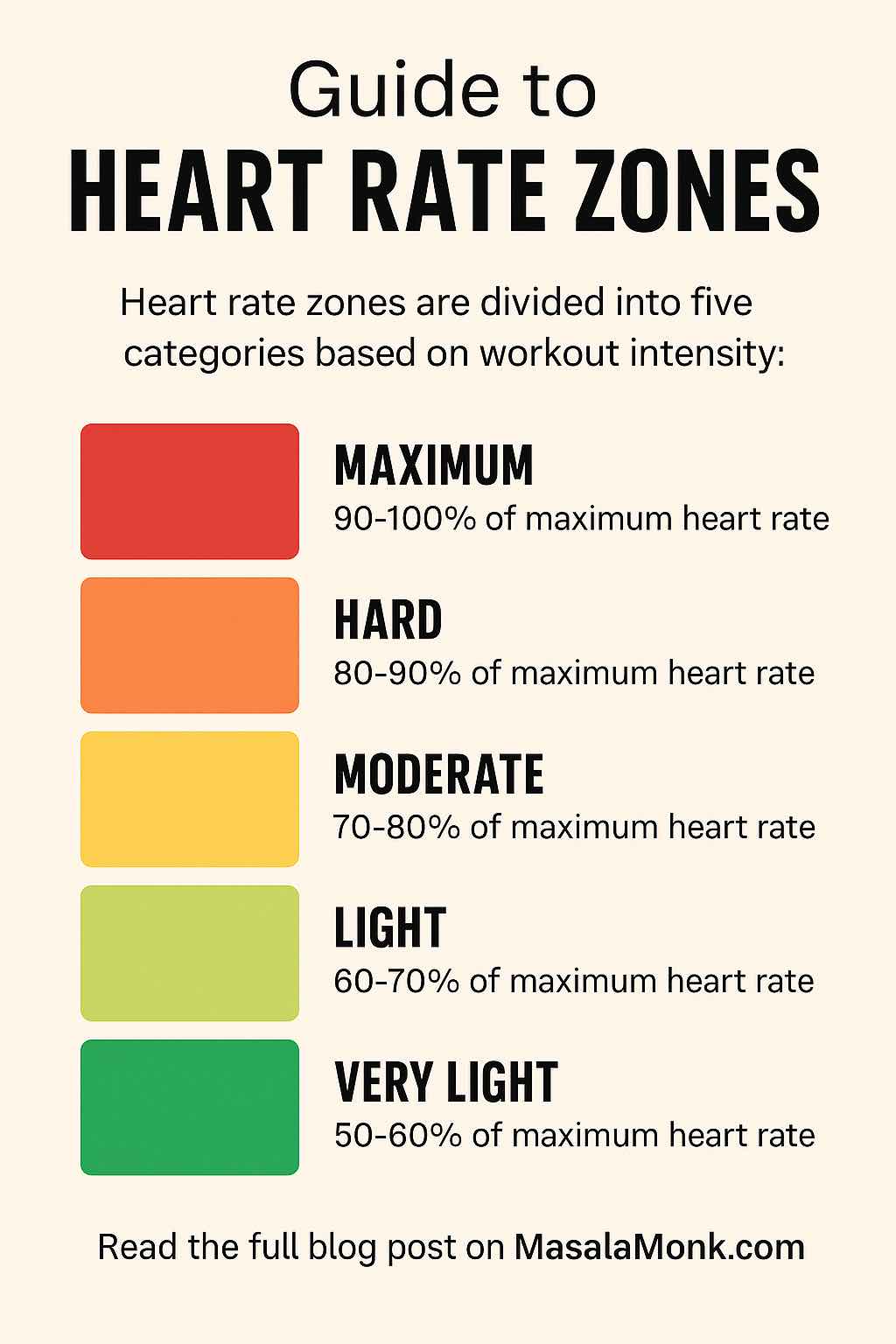
In today’s fitness landscape, few metrics are as powerful, actionable, and widely misunderstood as heart rate zones. Whether you’re training for fat loss, endurance, metabolic health, or peak athletic performance, heart rate zone training provides a simple yet highly personalized roadmap to achieving your goals.
Thanks to advances in wearable technology, data science, and exercise physiology, 2025 offers better insights than ever before into how your heart rate responds to exercise. In this comprehensive guide, we break down everything you need to know about heart rate zones — backed by the latest research.
What Are Heart Rate Zones?
Heart rate zones are specific ranges of your heart rate that correspond to different levels of exercise intensity. Each zone triggers different physiological responses in your body — from fat burning and aerobic conditioning to anaerobic capacity and maximal performance.
Your heart rate rises as you increase exercise intensity, but your body’s energy systems shift along the way. Understanding where you are on that continuum allows you to train smarter, avoid burnout, and maximize results.
The 5 Standard Heart Rate Zones
| Zone | % Max HR | Description | Primary Benefits |
|---|---|---|---|
| Zone 1 | 50–60% | Very Light | Recovery, warm-up, mobility |
| Zone 2 | 60–70% | Light/Aerobic | Fat metabolism, endurance, mitochondrial health |
| Zone 3 | 70–80% | Moderate | Fitness maintenance, mixed fuel usage |
| Zone 4 | 80–90% | Hard/Anaerobic | Speed, power, lactate threshold |
| Zone 5 | 90–100% | Peak | Maximal output, VO₂max development, sprint performance |
Each zone has a distinct purpose. Your long-term results depend on how you balance time spent in each.
Why Heart Rate Zone Training Works
At lower intensities (Zones 1–2), your body primarily burns fat for fuel, improving cardiovascular efficiency and metabolic flexibility. As intensity rises (Zones 3–5), carbohydrates take over, lactate builds, and anaerobic systems dominate.
Zone training allows you to:
- Target specific adaptations based on your fitness goals
- Balance intensity and recovery to avoid overtraining
- Maximize workout efficiency by spending more time at the right intensities
- Personalize your training based on your physiology
How to Calculate Your Heart Rate Zones
The Simple Formula (220 − Age)
The easiest way to estimate your maximum heart rate (HRmax) is:
220 − your age = Max HR
Example for a 50-year-old:
220 − 50 = 170 bpm
While widely used, this formula can vary by ±10–15 bpm for individuals.
The Karvonen Formula (More Accurate)
By incorporating your resting heart rate (RHR), you personalize your zones:
Target HR = [(Max HR − RHR) × %Intensity] + RHR
Example for 50-year-old with RHR of 60 bpm:
Max HR = 170 bpm
Zone 2 (60–70%):
- Lower end:
[(170−60)×0.60] + 60 = 126 bpm - Upper end:
[(170−60)×0.70] + 60 = 137 bpm
So Zone 2 would be ~126–137 bpm.
Lab Testing & Wearable Estimates
- VO₂max and lactate threshold testing give precise zone definitions.
- Modern wearables (Garmin, Polar, WHOOP, Apple Watch) estimate these values using advanced algorithms, continuous heart rate tracking, and HRV data.
Personalized Heart Rate Zones by Age
Since HRmax decreases with age, your zones shift over time:
| Age | Max HR | Zone 2 (60–70%) | Zone 4 (80–90%) |
|---|---|---|---|
| 30 | 190 bpm | 114–133 bpm | 152–171 bpm |
| 40 | 180 bpm | 108–126 bpm | 144–162 bpm |
| 50 | 170 bpm | 102–119 bpm | 136–153 bpm |
| 60 | 160 bpm | 96–112 bpm | 128–144 bpm |
| 70 | 150 bpm | 90–105 bpm | 120–135 bpm |
Individual testing always provides greater accuracy.
Zone 2 Training: The 2025 Game Changer
One of the biggest breakthroughs in fitness in recent years has been the growing recognition of Zone 2 training as foundational for both health and performance.
Benefits of Zone 2 Training
- Boosts mitochondrial density and metabolic health
- Improves fat oxidation and insulin sensitivity
- Builds aerobic endurance without excessive fatigue
- Lowers chronic inflammation markers
- Supports long-term cardiovascular health and longevity
Why Top Athletes Use the 80/20 Rule
Endurance athletes now widely adopt the 80/20 rule:
80% of training time in Zone 2; 20% in high-intensity Zones 4–5.
This balance allows athletes to accumulate large training volumes without chronic stress, while still building peak performance capabilities.
Resting Heart Rate & Recovery Zones
Your resting heart rate (RHR) and recovery data offer insight into your cardiovascular health and readiness to train.
Resting Heart Rate
- Elite athletes: 40–50 bpm
- Fit adults: 50–60 bpm
- Average: 60–80 bpm
- Elevated RHR may signal stress, fatigue, overtraining, dehydration, or illness.
Recovery Heart Rate
After exercise, your heart rate should drop quickly:
- A 20 bpm drop in the first minute is a positive indicator.
- Slower recovery suggests reduced fitness or overtraining.
Heart Rate Variability (HRV)
HRV measures the variation in time between heartbeats. In general:
- Higher HRV = better recovery, parasympathetic dominance.
- Lower HRV = fatigue, stress, or illness.
In 2025, HRV-guided training is used by elite athletes, corporate wellness programs, and recreational fitness enthusiasts to optimize training loads.
Devices for Tracking Your Heart Rate Zones
Accurate heart rate data makes zone training effective. Not all devices are created equal.
Chest Straps
- Direct ECG measurement (gold standard for real-time data)
- Excellent for interval, cycling, and high-intensity training
- Brands: Polar H10, Garmin HRM-Pro
Wrist-Based Wearables
- Convenient for 24/7 monitoring (RHR, HRV, sleep)
- Less accurate during high-intensity or dynamic movement
- Leading 2025 models: Garmin Forerunner 965, Apple Watch Ultra 2, WHOOP 4.0, Polar Vantage V3
Optical Armbands
- Good accuracy with better motion stability than wrist devices
- Popular options: Polar Verity Sense, Scosche Rhythm+
Modern wearables also estimate VO₂max, lactate threshold, recovery scores, and sleep metrics, making heart rate zone training more precise than ever.
Common Heart Rate Training Mistakes
Even with data at your fingertips, many people fall into these traps:
- Training too hard too often: Overreliance on Zone 3 (“junk miles”)
- Ignoring recovery needs: Skipping rest days and neglecting HRV signals
- Basing zones only on formulas: Personalized testing improves precision
- Chasing wearables metrics without understanding limitations
- Inconsistency: Results require consistency, not occasional bursts of effort
Heart Rate Zone Quick Reference
| Zone | % Max HR | Key Focus |
|---|---|---|
| Zone 1 | 50–60% | Recovery, warm-up |
| Zone 2 | 60–70% | Fat burning, endurance |
| Zone 3 | 70–80% | Fitness maintenance |
| Zone 4 | 80–90% | Lactate threshold, performance |
| Zone 5 | 90–100% | VO₂max, peak power |
Conclusion: Mastering Heart Rate Zones for Smarter Training
Heart rate zone training offers the most accessible, affordable, and evidence-based approach to personalized fitness. It empowers you to target specific goals, avoid overtraining, and build long-term resilience.
Whether you’re an elite athlete, weekend warrior, or simply someone striving for better health, understanding your heart rate zones will optimize your efforts and deliver superior results.
In 2025, with advanced wearables and better science, zone training is no longer guesswork — it’s precision fitness for everyone.
📌 10 FAQs with Answers
1️⃣ What are heart rate zones?
Heart rate zones are specific ranges of your maximum heart rate that correspond to different levels of exercise intensity. Each zone targets a different training effect — from fat burning and endurance (Zone 2) to peak performance (Zone 5).
2️⃣ How do I calculate my heart rate zones?
You can estimate your maximum heart rate using:
220 minus your age.
For better accuracy, use the Karvonen Formula, which includes your resting heart rate:
Target HR = [(Max HR − Resting HR) × %Intensity] + Resting HR.
3️⃣ What is the best heart rate zone for fat burning?
Zone 2 (60–70% of your max heart rate) is optimal for fat metabolism and building aerobic endurance. This zone improves mitochondrial function, metabolic health, and long-term fat utilization.
4️⃣ Why is Zone 2 training so popular in 2025?
Zone 2 training is backed by strong research showing its benefits for endurance, fat burning, longevity, and metabolic health — all with minimal stress and faster recovery. It’s now widely used by elite athletes and everyday fitness enthusiasts.
5️⃣ How do wearables calculate heart rate zones?
Modern wearables use continuous heart rate tracking, heart rate variability (HRV), sleep data, and activity profiles to estimate your VO₂max, lactate threshold, and personalized zones. Devices like Garmin, WHOOP, Polar, and Apple Watch have become highly advanced in 2025.
6️⃣ What is resting heart rate and why does it matter?
Resting heart rate (RHR) measures your heartbeats per minute at complete rest. Lower RHR generally reflects better cardiovascular fitness and recovery. Elevated RHR may indicate stress, illness, or overtraining.
7️⃣ What is HRV and how does it affect training?
Heart Rate Variability (HRV) measures the variation in time between heartbeats. High HRV typically indicates good recovery and nervous system balance, while low HRV suggests fatigue or stress. Many athletes now use HRV to adjust daily training loads.
8️⃣ Is heart rate training better than just running by pace?
Yes. Heart rate training reflects your body’s actual workload rather than external pace, which can fluctuate due to fatigue, heat, stress, or illness. It’s more individualized and adaptable to real-time fitness levels.
9️⃣ How can I improve my heart rate recovery?
Consistent aerobic training (especially in Zone 2), proper hydration, sleep, stress management, and adequate recovery all contribute to faster heart rate recovery after workouts.
🔟 How often should I train in each heart rate zone?
General guidelines suggest:
- ~80% in Zone 2 (low intensity)
- ~20% in higher zones (Zone 4-5 for performance)
This approach builds endurance while minimizing injury and burnout.











